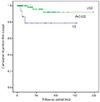1. Morice P, Uzan C, Fauvet R, Gouy S, Duvillard P, Darai E. Borderline ovarian tumour: pathological diagnostic dilemma and risk factors for invasive or lethal recurrence. Lancet Oncol. 2012; 13:e103–e115.
2. Tinelli R, Tinelli A, Tinelli FG, Cicinelli E, Malvasi A. Conservative surgery for borderline ovarian tumors: a review. Gynecol Oncol. 2006; 100:185–191.
3. Skirnisdottir I, Garmo H, Wilander E, Holmberg L. Borderline ovarian tumors in Sweden 1960-2005: trends in incidence and age at diagnosis compared to ovarian cancer. Int J Cancer. 2008; 123:1897–1901.
4. Ouldamer L, Bendifallah S, Naoura I, Body G, Uzan C, Morice P, et al. Nomogram to predict live birth rate after fertility-sparing surgery for borderline ovarian tumours. Hum Reprod. 2016; 31:1732–1737.
5. Gungor T, Cetinkaya N, Yalcin H, Ozdal B, Ozgu E, Baser E, et al. Retrospective evaluation of borderline ovarian tumors: single center experience of 183 cases. Arch Gynecol Obstet. 2015; 291:123–130.
6. De Iaco P, Ferrero A, Rosati F, Melpignano M, Biglia N, Rolla M, et al. Behaviour of ovarian tumors of low malignant potential treated with conservative surgery. Eur J Surg Oncol. 2009; 35:643–648.
7. Levine J, Canada A, Stern CJ. Fertility preservation in adolescents and young adults with cancer. J Clin Oncol. 2010; 28:4831–4841.
8. Uzan C, Nikpayam M, Ribassin-Majed L, Gouy S, Bendifallah S, Cortez A, et al. Influence of histological subtypes on the risk of an invasive recurrence in a large series of stage I borderline ovarian tumor including 191 conservative treatments. Ann Oncol. 2014; 25:1312–1319.
9. Kwon YS, Hahn HS, Kim TJ, Lee IH, Lim KT, Lee KH, et al. Fertility preservation in patients with early epithelial ovarian cancer. J Gynecol Oncol. 2009; 20:44–47.
10. Donnez J, Martinez-Madrid B, Jadoul P, Van Langendonckt A, Demylle D, Dolmans MM. Ovarian tissue cryopreservation and transplantation: a review. Hum Reprod Update. 2006; 12:519–535.
11. Donnez J, Munschke A, Berliere M, Pirard C, Jadoul P, Smets M, et al. Safety of conservative management and fertility outcome in women with borderline tumors of the ovary. Fertil Steril. 2003; 79:1216–1221.
12. Morice P, Camatte S, Wicart-Poque F, Atallah D, Rouzier R, Pautier P, et al. Results of conservative management of epithelial malignant and borderline ovarian tumours. Hum Reprod Update. 2003; 9:185–192.
13. Park JY, Kim DY, Kim JH, Kim YM, Kim YT, Nam JH. Surgical management of borderline ovarian tumors: the role of fertility-sparing surgery. Gynecol Oncol. 2009; 113:75–82.
14. Fauvet R, Poncelet C, Boccara J, Descamps P, Fondrinier E, Darai E. Fertility after conservative treatment for borderline ovarian tumors: a French multicenter study. Fertil Steril. 2005; 83:284–290.
15. Yinon Y, Beiner ME, Gotlieb WH, Korach Y, Perri T, Ben-Baruch G. Clinical outcome of cystectomy compared with unilateral salpingo-oophorectomy as fertility-sparing treatment of borderline ovarian tumors. Fertil Steril. 2007; 88:479–484.
16. Song T, Hun Choi C, Lee YY, Kim TJ, Lee JW, Bae DS, et al. Oncologic and reproductive outcomes of cystectomy compared with oophorectomy as a treatment for borderline ovarian tumours. Hum Reprod. 2011; 26:2008–2014.
17. Song T, Lee YY, Choi CH, Kim TJ, Lee JW, Bae DS, et al. Histologic distribution of borderline ovarian tumors worldwide: a systematic review. J Gynecol Oncol. 2013; 24:44–51.
18. Koskas M, Uzan C, Gouy S, Pautier P, Lhomme C, Haie-Meder C, et al. Fertility determinants after conservative surgery for mucinous borderline tumours of the ovary (excluding peritoneal pseudomyxoma). Hum Reprod. 2011; 26:808–814.
19. Koskas M, Uzan C, Gouy S, Pautier P, Lhomme C, Haie-Meder C, et al. Prognostic factors of a large retrospective series of mucinous borderline tumors of the ovary (excluding peritoneal pseudomyxoma). Ann Surg Oncol. 2011; 18:40–48.
20. Park JY, Kim DY, Suh DS, Kim JH, Kim YM, Kim YT, et al. Outcomes of fertility-sparing surgery for invasive epithelial ovarian cancer: oncologic safety and reproductive outcomes. Gynecol Oncol. 2008; 110:345–353.
21. Schilder JM, Thompson AM, DePriest PD, Ueland FR, Cibull ML, Kryscio RJ, et al. Outcome of reproductive age women with stage IA or IC invasive epithelial ovarian cancer treated with fertility-sparing therapy. Gynecol Oncol. 2002; 87:1–7.
22. Song T, Choi CH, Kim HJ, Lee W, Lee YY, Kim TJ, et al. Oncologic and reproductive outcomes in patients with advanced-stage borderline ovarian tumors. Eur J Obstet Gynecol Reprod Biol. 2011; 156:204–208.
23. Uzan C, Kane A, Rey A, Gouy S, Duvillard P, Morice P. Outcomes after conservative treatment of advanced-stage serous borderline tumors of the ovary. Ann Oncol. 2010; 21:55–60.
24. Vasconcelos I, de Sousa Mendes M. Conservative surgery in ovarian borderline tumours: a meta-analysis with emphasis on recurrence risk. Eur J Cancer. 2015; 51:620–631.
25. Barakat RR, Benjamin I, Lewis JL Jr, Saigo PE, Curtin JP, Hoskins WJ. Platinum-based chemotherapy for advanced-stage serous ovarian carcinoma of low malignant potential. Gynecol Oncol. 1995; 59:390–393.
26. Fischerova D, Zikan M, Dundr P, Cibula D. Diagnosis, treatment, and follow-up of borderline ovarian tumors. Oncologist. 2012; 17:1515–1533.
27. Shih KK, Zhou QC, Aghajanian C, Huh J, Soslow RA, Morgan JC, et al. Patterns of recurrence and role of adjuvant chemotherapy in stage II-IV serous ovarian borderline tumors. Gynecol Oncol. 2010; 119:270–273.
28. Gershenson DM, Silva EG, Levy L, Burke TW, Wolf JK, Tornos C. Ovarian serous borderline tumors with invasive peritoneal implants. Cancer. 1998; 82:1096–1103.
29. Uzan C, Muller E, Kane A, Rey A, Gouy S, Bendiffallah S, et al. Prognostic factors for recurrence after conservative treatment in a series of 119 patients with stage I serous borderline tumors of the ovary. Ann Oncol. 2014; 25:166–171.
30. Vasconcelos I, Olschewski J, Braicu I, Sehouli J. Limited efficacy of platinum-based adjuvant treatment on the outcome of borderline ovarian tumors. Eur J Obstet Gynecol Reprod Biol. 2015; 186:26–33.








 PDF
PDF ePub
ePub Citation
Citation Print
Print



 XML Download
XML Download